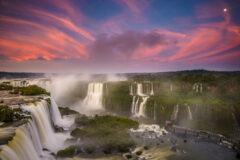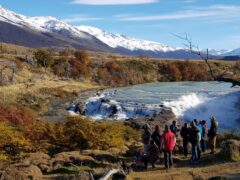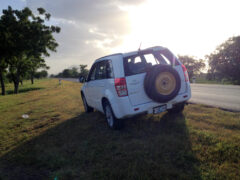The Rolls-Royce School of Off-Roading

"How much for your car?" grinned the man washing car windows on the 12-lane wide Avenida 9 Julio at the heart of Buenos Aires as we waited for what felt like the fiftieth red light in as many metres.
Having only just collected one of the most magnificent cars in the world, the Rolls-Royce Phantom, this was the first time anyone had asked this. Over the next three weeks I was to discover that it would most certainly not be the last.
I fumbled in the mental bin my GCSE Spanish had been in for the last 18 years while wrestling with an exchange rate conversion into a still unfamiliar currency. This took some time. Fortunately for my inquisitive new friend, the light was still red when I got there. ‘One million six hundred thousand Argentinian pesos’ I haltingly managed in awful Spanish.
The window cleaner laughed, threw his arms up, did a small dance and ran over to his mate several lanes across and relayed this information. As the lights finally went green and we pulled away, they were still laughing, shouting and pointing at the car. This was going to be a good trip.
The next three weeks would see 6000 miles pass beneath the Phantom’s huge wheels as endlessly changing natural beauty came and went around us. We worked our way across central Argentina over the Andes to the beaches and deserts of Chile beyond before cutting cross-country back to Buenos Aires for one last steak and a flight back to the UK.
Leaving the grand Alvear Palace and the rich cosmopolitan vibrancy of the Argentine capital behind took forever. The city sprawls unchecked for miles in every direction, but finally it petered out, as did the road which went from dual carriageway to crater-scarred singletrack in as long as it’s taken you to read this sentence. Despite having no map other than an internet print out with less detail than the average colouring book, we found our first stop, the Estancia Villa Maria, 50 miles or so beyond the Buenos Aires city limits.
Built for one of Argentina’s wealthiest families the sprawling manor house at the end of the Villa’s three mile-long private driveway is now a boutique hotel.
With a development including a polo school, a spa, an 18-hole golf course and a tennis centre imminent, only 600 cattle remain on the Estancia - although when your Rolls Royce is parked among them in a field roughly the size of Belgium, they’re still more than capable of destroying it. But the Phantom emerged miraculously scuff-free as a well-seasoned gaucho immaculately hearded the cattle past for a picture opportunity. Gauchos are Argentina’s cowboys for whom horse riding is as natural as walking.
After steak and red wine for dinner - the staple diet out here in the country’s cattle-growing heartland - and a good night’s rest, it was back on the road to Mendoza.
Nestled in the Argentine foothills of the Andes, this is the country’s wine region. Here in the shadow of the world’s longest mountain range, the elevation changes and climate are so suited to vineyards that the French Malbec grape, imported at the end of the 19th century, grows better here than in its native France.
After a relaxing night in Mendoza’s Park Hyatt, day breaks over the city as we hit Ruta 7. This main road is part of the Pan-American highway and stretches across the Andes into Chile beyond.
It is also one of the world’s greatest driving roads. Beautifully-surfaced and with barely any traffic it snakes its way up into the mountains, rewarding you with majestic views at every turn as the golden desert-like base of the Andes slowly turns to vertical grey crags of snow-coated monolith during the ascent. Just don’t try coming here in winter - once the snow closes the road it stays that way until spring.
Up at the Chilean border things happen slowly at the best of times so you can imagine the chaos our arrival in a brand new Rolls Royce wearing UK plates caused. Four hours and a ration book’s worth of stamps later however, we were free and heading down into Chile. In the dark, the road is treacherou ,and, unlike the flowing Argentinian side, drops much more steeply requiring far more hairpins, all of which give the inattentive driver the opportunity to plunge several hundred feet to certain death in the gully below. It’s a testing few hours exacerbated by unlit lorries materialising out of the gloom in front of us doing about 12mph. Rolling into the car park at Santiago’s Ritz-Carlton as midnight approaches, I’m exhausted and crash out immediately.
Santiago is an easy city to get lost in for the foreign driver and leaving the next morning takes at least an hour longer than it should. We are repeatedly hamstrung by one-way streets going the wrong way and huge traffic jams, including a rather excellent one when we find ourselves stuck in the middle of a changing of the guard ceremony outside the presidential palace.
Finally slipping Santiago’s clutches we set course for the Pacific to the west before turning north and hugging the coast road all the way up into the Atacama desert some 800 miles away.
The world’s driest and highest desert, the Atacama has many weather stations, some of which have never seen rain. In fact, average rainfall in the region is just 1mm per year. It looks like a cross between Marlboro country and the moon and as the sun moves overhead the colours of this wilderness change constantly. Dusty shale-oated plains turn from pink to grey while canyon walls and towers light up in an ever-changing variety of reds, yellows and purples.
All the while the road twists and turns through this harsh yet beautiful vista, the only other signs of human presence are the many roadside crosses to those who made a sudden detour to a final destination they didn’t plan to visit after the relentlessly empty roads caught them out.
In many places it’s dirt track only. Not the ideal habitat for one of the world’s finest luxury cars, you might think. But you’d be wrong. Hit a button and the Phantom will raise itself three inches on its haunches for extra ground-clearance. Off-road trail-bashing may not have been quite what Rolls-Royce had in mind when adding this, but it works a treat, lifting the huge car clear of the worst the trail has to offer and, providing you keep above 50mph, creating a hovercraft-styled floating sensation to the ride as you barrel along, with a vast plume of desert debris pouring from the spinning rear wheels. Truly excellent.
After a couple of nights in the spectacular Tierra Atacama Resort in San Pedro de Atacama on the desert’s edge, it’s time for the long trek back to Buenos Aires. It takes three solid days of driving 12 hours a day to make the return trip. Once over the border, passing through yet more stunning high-Andean scenery, we arrived in Salta - the fine, colonial capital of Argentina’s rugged north west corner. The comfortable Solar de la Plaza hotel is our last stop before Buenos Aires.
With almost no motorways, and in extreme cases no roads, covering the miles here isn’t quite the same as doing it at home. Non-existent road signs make navigation interesting as do non-existent streetlights anywhere once the sun goes down. Throw in the Russian-roulette road surfaces, which spin from billiard table to bombsite at will, and wild animals inches from wandering into your path: driving here is not for the faint-hearted. If you’re up for the challenge though I couldn’t recommend it highly enough. It’s the ideal way to see the wild natural beauty of both Argentina and Chile as it slides by. Local hospitality everywhere is truly off-the-scale.
Eventually crawling back into Buenos Aires in the heart of the afternoon rush hour, the car is filthy but despite the extreme rigours of the last 6000 miles has refused to miss a beat - they build them tough at Goodwood - and as we grind our way onto the Avenida 9 Julio for the last time, a familiar face appears at the window.
"Two hundred and seventy thousand English pounds!" the window cleaner exclaims in halting English, beaming broadly. We shake hands as the light goes green and as I pull away he’s still waving and laughing amidst the 12 lanes of traffic around him.
What a trip, what a place.
Jeremy Hart, writer for Condé Nast Traveller and The Times
Tailor-made holidays
Flexible, custom-made holidays to Latin America created to match your exact requirements: our tailor-made itineraries are as unique as the clients for whom they are designed.
Design my tripPapagaio
Your edit for Latin American inspiration
Our exciting range of articles on Latin America explore everything from iconic destinations and lesser-known cultural gems to delicious traditional recipes. You’ll also find exclusive travel tips, first-hand client reviews and the chance to get your personal questions answered by our travel experts.
View Extraordinary Inspiration






































